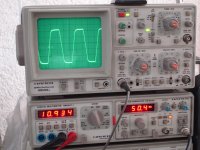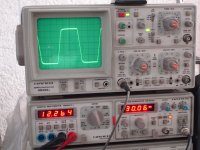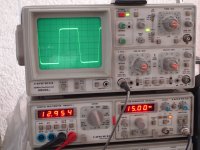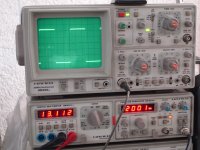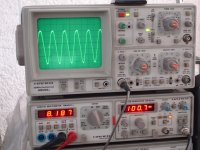P3A
Some of mine amplifiers are on youtube.
It's interesting see other opinions about this.
For more easy comparison i manage to play same music part.
Try compare this one.http://www.youtube.com/watch?v=kggfDVqPkRQ
With this one.http://www.youtube.com/watch?v=M26LSrIB8qA
For better results desktop pc is recommended.
Nice vid. Clean and dynamic sound. Bass seems powerful. How does it compare with your other amps?
Some of mine amplifiers are on youtube.
It's interesting see other opinions about this.
For more easy comparison i manage to play same music part.
Try compare this one.http://www.youtube.com/watch?v=kggfDVqPkRQ
With this one.http://www.youtube.com/watch?v=M26LSrIB8qA
For better results desktop pc is recommended.
Last edited:
There is a lot of noise on the P3A vid, making it muddier compared to Apex. Snare drum hits a lot cleaner on the Apex. Why so much static in the P3A? Mine is dead silent on 93dB dome tweeters.
P3A
If you say for start of video it's noise of a t.v set. I apologize for this.I shut down t.v set some seconds later.There is a lot of noise on the P3A vid, making it muddier compared to Apex. Snare drum hits a lot cleaner on the Apex. Why so much static in the P3A? Mine is dead silent on 93dB dome tweeters.
Last edited:
Perhaps it's a common fault in my PC sound systems, but I tried 3 PCs, one with a reference ESI Juli@ card and one a laptop with an external DAC, to get an idea why I heard a constant hiss and clicking like a badly worn vinyl record. There wasn't a lot of difference between systems. Still, I take your point about valid comparisons, Gareth. I have sensed that too and I agree with chlorofille that this recording seemed dynamic, like the source material but it was also overmodulating (splatter, in radio speak) and this was causing sound to break up on peaks which sounded bad.
Really, the MP3 quality was not the main problem. It could have been flac quality, but the noise and distortion would still have confused whether the amplifier had anything specific to do with sound quality. Am I the only one who hears the dominant background noise and overload artefacts?
I don't want to deter you from your efforts though, Thimios. Good for you, trying to share your listening pleasure and I hope it sounds many times better at home, like P3a and other great sounding amps should. I would work at a home speaker project next, to make sure you get the fidelity that's needed to get the best out of your system.
Really, the MP3 quality was not the main problem. It could have been flac quality, but the noise and distortion would still have confused whether the amplifier had anything specific to do with sound quality. Am I the only one who hears the dominant background noise and overload artefacts?
I don't want to deter you from your efforts though, Thimios. Good for you, trying to share your listening pleasure and I hope it sounds many times better at home, like P3a and other great sounding amps should. I would work at a home speaker project next, to make sure you get the fidelity that's needed to get the best out of your system.
P3A
Hi Ian Finch.
Thank you for your time you spent listening.
As i have mention there is a voice of a tv set (his) in the start of this video.
Is this what you and chlorofille mentioned?
Unfortunately my desktop pc refuses to boot this days.
My laptop is old and the sound is just a poor sound.
I must capture another video ,this time hope with more attention .
Ok just now listening this with headphones and understand the problem.
This video uploaded with this old laptop.I believe that is an issue of sound card.
I must delete this and upload another video when i repair my desctop pc .
best regards and sorry for this.
Perhaps it's a common fault in my PC sound systems, but I tried 3 PCs, one with a reference ESI Juli@ card and one a laptop with an external DAC, to get an idea why I heard a constant hiss and clicking like a badly worn vinyl record. There wasn't a lot of difference between systems. Still, I take your point about valid comparisons, Gareth. I have sensed that too and I agree with chlorofille that this recording seemed dynamic, like the source material but it was also overmodulating (splatter, in radio speak) and this was causing sound to break up on peaks which sounded bad.
Really, the MP3 quality was not the main problem. It could have been flac quality, but the noise and distortion would still have confused whether the amplifier had anything specific to do with sound quality. Am I the only one who hears the dominant background noise and overload artefacts?
I don't want to deter you from your efforts though, Thimios. Good for you, trying to share your listening pleasure and I hope it sounds many times better at home, like P3a and other great sounding amps should. I would work at a home speaker project next, to make sure you get the fidelity that's needed to get the best out of your system.
Hi Ian Finch.
Thank you for your time you spent listening.
As i have mention there is a voice of a tv set (his) in the start of this video.
Is this what you and chlorofille mentioned?
Unfortunately my desktop pc refuses to boot this days.
My laptop is old and the sound is just a poor sound.
I must capture another video ,this time hope with more attention .
Ok just now listening this with headphones and understand the problem.
This video uploaded with this old laptop.I believe that is an issue of sound card.
I must delete this and upload another video when i repair my desctop pc .
best regards and sorry for this.
Last edited:
You heard a difference because both amps were played in the same video. What you didn't hear was 'exactly how' each amp sounds on it's own. If a difference is there, no matter what the MP3 processing did, there is a good chance you can hear a difference. But I'd think it's VERY unlikely that you heard the difference 'as it really is' ! I guess you get my point !🙂
Hi Ian Finch.
Thank you for your time you spent listening.
As i have mention there is a voice of a tv set (his) in the start of this video.
Is this what you and chlorofille mentioned?
Unfortunately my desktop pc refuses to boot this days.
My laptop is old and the sound is just a poor sound.
I must capture another video ,this time hope with more attention .
Ok just now listening this with headphones and understand the problem.
This video uploaded with this old laptop.I believe that is an issue of sound card.
I must delete this and upload another video when i repair my desctop pc .
best regards and sorry for this.
Hi Thimios

We have same amps, don't we 😉
Better to make one video that can play more than one amp...
So the comparison is more fair, only change the amp.
Speakers, source, video taken, etc should be the same.
I'm in the progress making the new P3A PCB,
the big caps is on the middle that supply both channel.
Kind Regards
John
P3A
Hi friend i wait your pcb!
This new video replace all others about P3A.http://www.youtube.com/watch?v=LUgWjOxNueo
Reason of replacement is a background noise issue because of USB capture method.
This time capture made via firewire.
Thanks all of you.
Regards.
Hi friend i wait your pcb!
This new video replace all others about P3A.http://www.youtube.com/watch?v=LUgWjOxNueo
Reason of replacement is a background noise issue because of USB capture method.
This time capture made via firewire.
Thanks all of you.
Regards.
Last edited:
Back to regulated bootstrap and Ian ...
Well Ian using the line of 35 regulated volts which actually is a very wide spread that includes distribution all over preamplifier , tuner and RIAA which at some point includes also the triple selector switch that switches something for the tuner instruments plus some AC for the tuner bulbs ..
When this 35 V suffers from all that and then trying to mimic a 30 V rail via a resistor this a very bad practice ...Especially if something goes wrong to all the above mentioned auxiliary circuits will also have a direct impact to bringing the amplifier out of balance .... Like actually happens a failure in the tuner takes down the 35V into 28 effecting also 12V aux psu resulting offset in the amplifier that protection clicks without amplifier error .
Regulating only the bootstrap is inefficient if implemented like that obviously needs to be regulated in the down side also and then probably totally in the front end with a dedicated psu and probably very close to be effective .
Still i will make my tests which i think that eventually will end up to remove the resistor and tie the bootstrap to the rail of the very stiff power supply 200W at least which is very close located to the amp boards and equipped with 2*10.000 ufd brand new caps .
Kind regards
Sakis
Well Ian using the line of 35 regulated volts which actually is a very wide spread that includes distribution all over preamplifier , tuner and RIAA which at some point includes also the triple selector switch that switches something for the tuner instruments plus some AC for the tuner bulbs ..
When this 35 V suffers from all that and then trying to mimic a 30 V rail via a resistor this a very bad practice ...Especially if something goes wrong to all the above mentioned auxiliary circuits will also have a direct impact to bringing the amplifier out of balance .... Like actually happens a failure in the tuner takes down the 35V into 28 effecting also 12V aux psu resulting offset in the amplifier that protection clicks without amplifier error .
Regulating only the bootstrap is inefficient if implemented like that obviously needs to be regulated in the down side also and then probably totally in the front end with a dedicated psu and probably very close to be effective .
Still i will make my tests which i think that eventually will end up to remove the resistor and tie the bootstrap to the rail of the very stiff power supply 200W at least which is very close located to the amp boards and equipped with 2*10.000 ufd brand new caps .
Kind regards
Sakis
P3A
Some measurments.
Some measurments.
Attachments
-
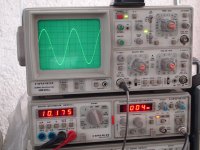 DSC06838.JPG572.4 KB · Views: 822
DSC06838.JPG572.4 KB · Views: 822 -
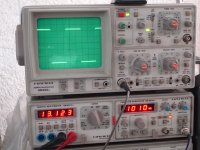 DSC06847.JPG560.8 KB · Views: 225
DSC06847.JPG560.8 KB · Views: 225 -
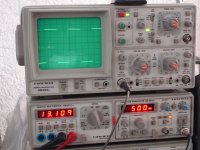 DSC06846.JPG562.8 KB · Views: 218
DSC06846.JPG562.8 KB · Views: 218 -
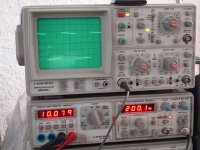 DSC06845.JPG565.1 KB · Views: 190
DSC06845.JPG565.1 KB · Views: 190 -
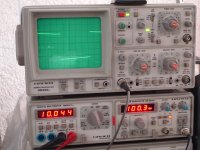 DSC06844.JPG568.8 KB · Views: 188
DSC06844.JPG568.8 KB · Views: 188 -
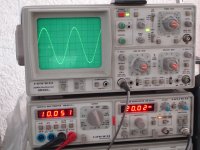 DSC06843.JPG556 KB · Views: 170
DSC06843.JPG556 KB · Views: 170 -
 DSC06842.JPG561.3 KB · Views: 708
DSC06842.JPG561.3 KB · Views: 708 -
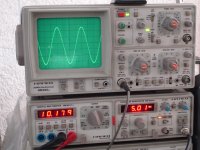 DSC06841.JPG567.3 KB · Views: 712
DSC06841.JPG567.3 KB · Views: 712 -
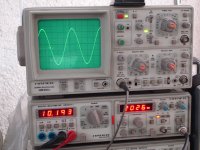 DSC06840.JPG567.5 KB · Views: 746
DSC06840.JPG567.5 KB · Views: 746 -
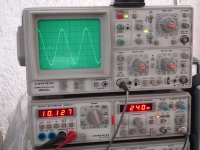 DSC06839.JPG566.7 KB · Views: 760
DSC06839.JPG566.7 KB · Views: 760
P3A
+/-35V
50mA Idle current
-28mV Offset
R Dummy load=8R
C inp.capas.=4u7 electrolytic
+/-35V
50mA Idle current
-28mV Offset
R Dummy load=8R
C inp.capas.=4u7 electrolytic
Attachments
Thimios ... measuring square wave in such a low frequency ( if i have seen correctly ) no more than 1KHZ will not tell you much
Expect 10 or 20 khz at very low power to present problems if there is any ...
Kind regards
Sakis
Expect 10 or 20 khz at very low power to present problems if there is any ...
Kind regards
Sakis
Member
Joined 2009
Paid Member
I have 1/10,000th the experience of you Sakis so please be patient as I have a different thought on this.
Firstly, a square wave, if an ideal one, has only rising and falling edges. We are looking to see how the amplifier responds to these edges and less at how it behaves during the time between. So at first we really don't care about the fundamental frequency, if it is 1kHz or 10kHz doesn't matter. We focus on the behaviour of the amplifier to the signal where it is changing rapidly.
There is a big danger in working at 10kHz or 20kHz - you increase the power dissipation of the amplifier by an order of magnitude. If you apply a large 20kHz square wave to an amplifier and into a load there is a good chance it is the last time your output devices are functioning.... it is a little safer at 1kHz.
Getting a good square wave isn't always easy. You want really good quality rising and falling edges with no nonsense going on. Well, the oscilloscope test point with 1KHz has been engineered for as close to perfect square wave as possible (within cost of unit) so you have a very nice test signal.
Just a thought.
Firstly, a square wave, if an ideal one, has only rising and falling edges. We are looking to see how the amplifier responds to these edges and less at how it behaves during the time between. So at first we really don't care about the fundamental frequency, if it is 1kHz or 10kHz doesn't matter. We focus on the behaviour of the amplifier to the signal where it is changing rapidly.
There is a big danger in working at 10kHz or 20kHz - you increase the power dissipation of the amplifier by an order of magnitude. If you apply a large 20kHz square wave to an amplifier and into a load there is a good chance it is the last time your output devices are functioning.... it is a little safer at 1kHz.
Getting a good square wave isn't always easy. You want really good quality rising and falling edges with no nonsense going on. Well, the oscilloscope test point with 1KHz has been engineered for as close to perfect square wave as possible (within cost of unit) so you have a very nice test signal.
Just a thought.
Gareth ..
testing an amplifier to these edges and above 10KHZ as said it only takes place in very low power ...But yes square wave with capacitive load is a nightmare for the amplifier ..
Ringing there is expected and from the looks of it you may understand many things .
A test as described above will not help much when you spec the amplifier ( except speed probably) But can and will present stability problems if any exist
I like the P3A i make to go easilly above 40KHZ square wave with no problems at all
Kind regards
Sakis
testing an amplifier to these edges and above 10KHZ as said it only takes place in very low power ...But yes square wave with capacitive load is a nightmare for the amplifier ..
Ringing there is expected and from the looks of it you may understand many things .
A test as described above will not help much when you spec the amplifier ( except speed probably) But can and will present stability problems if any exist
I like the P3A i make to go easilly above 40KHZ square wave with no problems at all
Kind regards
Sakis
POST#370 Last picture 8W 100KHZ
That is why i always put a paper sticker with the conditions makes it easier for people to read .
You are doing better than fine !! i hope you enjoy listening !!!
Kind regards
Sakis
P3A
Square Wave test in these levels(voltages, frequencies) is a stretch test.
Everybody can agree that a stretch test is useful or not.
Post#369.
SINUSOIDAL
1)100Hz/10V RMS
2)240Hz/10V RMS
3)2Khz/10V RMS
4)5Khz/10V RMS
5)10Khz/10V RMS
6)20Khz/10V RMS
SQUARE WAVE
7)100Hz/10V RMS
8)200Hz/10V RMS
9)500Hz/13V RMS
10)1Khz/13V RMS
POST#370
1)2Khz/13V RMS
2)10Khz/13V RMS
3)15Khz/13V RMS
4)20Khz/12.7V RMS
5)30Khz/12V RMS
6)50Khz/11V RMS
7)70Khz/9.8V RMS
8)100Khz/8.1V RMS
Regards.
Square Wave test in these levels(voltages, frequencies) is a stretch test.
Everybody can agree that a stretch test is useful or not.
Post#369.
SINUSOIDAL
1)100Hz/10V RMS
2)240Hz/10V RMS
3)2Khz/10V RMS
4)5Khz/10V RMS
5)10Khz/10V RMS
6)20Khz/10V RMS
SQUARE WAVE
7)100Hz/10V RMS
8)200Hz/10V RMS
9)500Hz/13V RMS
10)1Khz/13V RMS
POST#370
1)2Khz/13V RMS
2)10Khz/13V RMS
3)15Khz/13V RMS
4)20Khz/12.7V RMS
5)30Khz/12V RMS
6)50Khz/11V RMS
7)70Khz/9.8V RMS
8)100Khz/8.1V RMS
Regards.
Last edited:
Your low frequency (100Hz to 500Hz) squarewave signals show significant LF filtering.
What is the passband of the amplifier?
What is the passband of the scope probe?
What is the passband of the amplifier?
What is the passband of the scope probe?
You could be right but we are at a disadvantage, since we still don't know what model this is and the schematic snip doesn't tell us anything more than the supply is "35V regulated". The rest is a mystery that only you can assess. Let's see what you find and the comparitive clipping levels. 🙂Back to regulated bootstrap and Ian ...Still i will make my tests which i think that eventually will end up to remove the resistor and tie the bootstrap to the rail of the very stiff power supply 200W at least which is very close located to the amp boards and equipped with 2*10.000 ufd brand new caps ....Sakis
Its the Marantz 2225 schematic can be found anywhere but if you have troubles let me know i can email it to you
Kind regards
Sakis
Kind regards
Sakis
Thanks Sakis, I found the service manual of 2225L here. I assume the differences are to do with something unimportant like maybe the quadraphonic adaptor, line voltage or FM band range.
Hmm....only 0.5% THD? 😀
Still, these are now popular old models, so the distortion must be of the fairly good sounding variety. I used one as a bench amplifier for a few years but never with proper loudspeakers so ignored the sound quality, only being for testing purposes.
Hmm....only 0.5% THD? 😀
Still, these are now popular old models, so the distortion must be of the fairly good sounding variety. I used one as a bench amplifier for a few years but never with proper loudspeakers so ignored the sound quality, only being for testing purposes.
- Home
- Amplifiers
- Solid State
- P3A Comparison table ( long .... )

